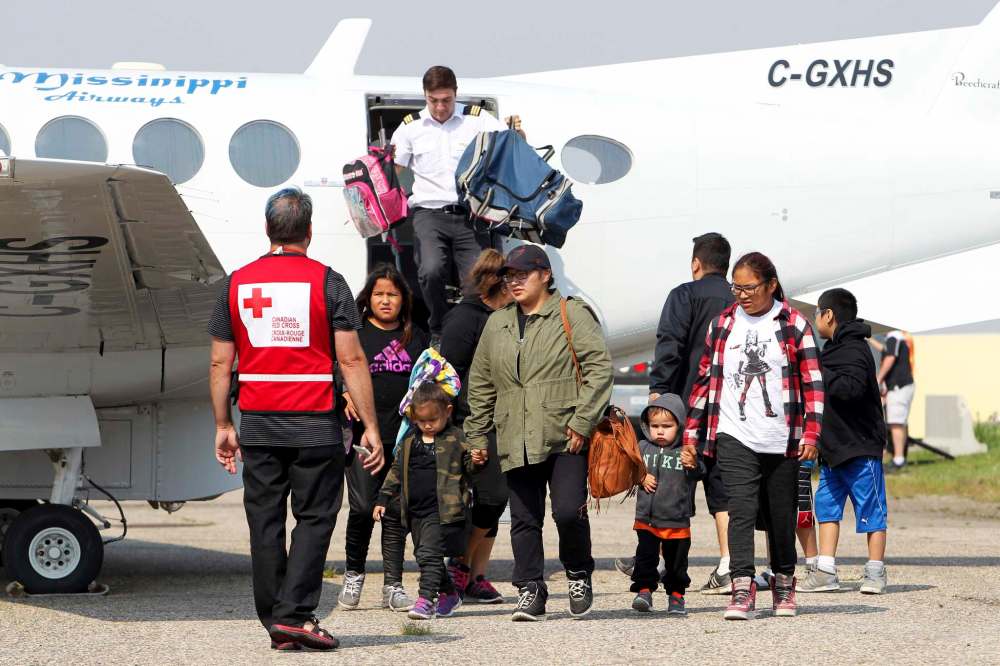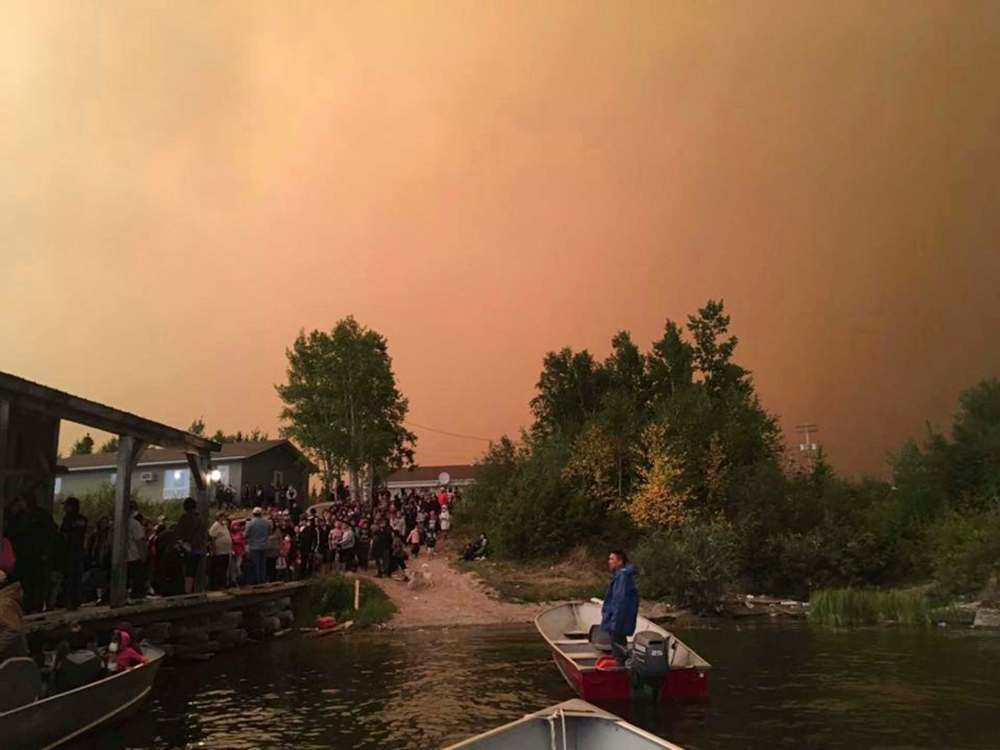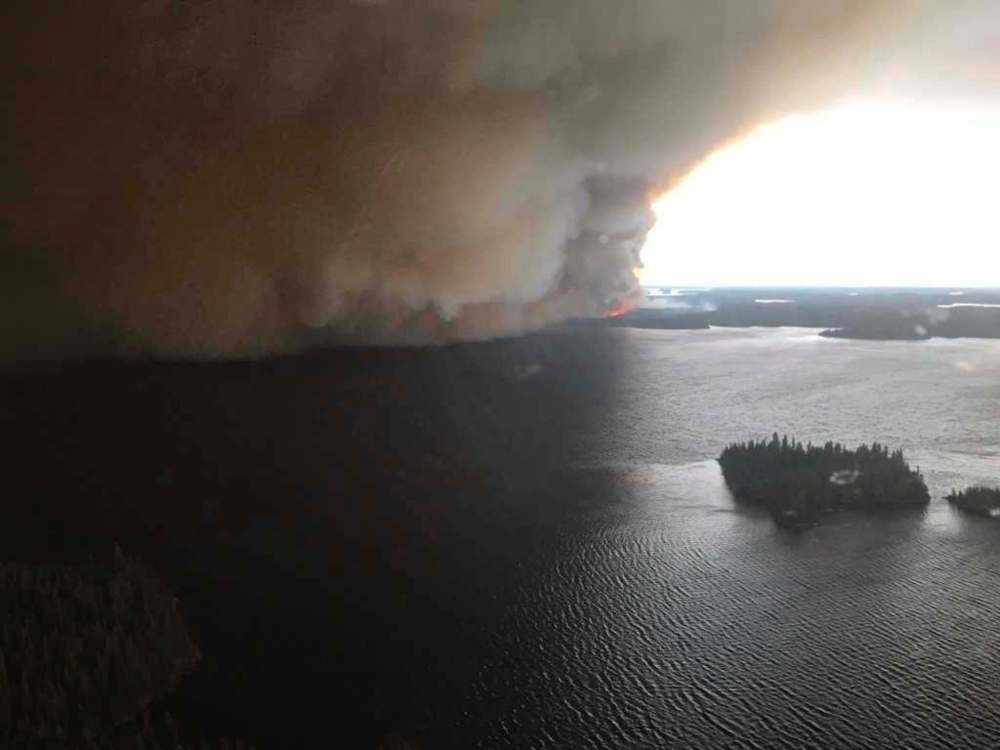Thousands forced to flee First Nations
Canadian military joins evacuation as forest fires threaten northern communities
Advertisement
Read this article for free:
or
Already have an account? Log in here »
To continue reading, please subscribe:
Monthly Digital Subscription
$0 for the first 4 weeks*
- Enjoy unlimited reading on winnipegfreepress.com
- Read the E-Edition, our digital replica newspaper
- Access News Break, our award-winning app
- Play interactive puzzles
*No charge for 4 weeks then price increases to the regular rate of $19.00 plus GST every four weeks. Offer available to new and qualified returning subscribers only. Cancel any time.
Monthly Digital Subscription
$4.75/week*
- Enjoy unlimited reading on winnipegfreepress.com
- Read the E-Edition, our digital replica newspaper
- Access News Break, our award-winning app
- Play interactive puzzles
*Billed as $19 plus GST every four weeks. Cancel any time.
To continue reading, please subscribe:
Add Free Press access to your Brandon Sun subscription for only an additional
$1 for the first 4 weeks*
*Your next subscription payment will increase by $1.00 and you will be charged $16.99 plus GST for four weeks. After four weeks, your payment will increase to $23.99 plus GST every four weeks.
Read unlimited articles for free today:
or
Already have an account? Log in here »
Hey there, time traveller!
This article was published 31/08/2017 (3017 days ago), so information in it may no longer be current.
The Canadian Armed Forces is getting involved in the airlift of thousands of people forced to flee their homes because of forest fires in northern Manitoba.
A massive fire threatening Island Lake communities had blazed to within 800 metres of homes on Wasagamack First Nation Wednesday afternoon and forced 3,700 people to flee their homes.
Two other major forest fires are threatening fly-in reserves in Poplar River and Fox Lake.
Sustainable Development Minister Rochelle Squires told a news conference Wednesday afternoon the 77,000-hectare fire had burned to within a kilometre from the closest residence in Wasagamack.
Everyone has been evacuated from the community of about 2,000.
That fire is also threatening St. Theresa Point and Garden Hill First Nations in the immediate area.

Acting on behalf of the federal government, the Canadian Red Cross has issued an unprecedented nationwide call for charter planes to airlift the evacuees, Shawn Feely, Canadian Red Cross vice-president for Manitoba and Nunavut, said at a news briefing Wednesday afternoon. Some 50 private charter airlines have pledged planes from across Canada to help with the airlift. Those pledged planes may not arrive soon enough, though.
So the Department of National Defence will send military planes to help the evacuation efforts in Wasagamack, the department said in an e-mailed statement Wednesday night.
“Our air personnel, soldiers and sailors stand ready to assist and serve fellow Canadians who face uncertainty and distress from natural disasters,” the statement said.
The statement did not specify when the planes would be heading north.
Meanwhile, Indigenous and Northern Affairs was “working to establish a shelter in Winnipeg for evacuees of the wildfires.”
That emergency shelter is going to be located at the RBC Convention Centre.
“We’re in the middle of planning right now, but yes, we will be an emergency shelter,” Klaus Lahr, CEO of the convention centre, told the Free Press Wednesday night. “We’re anticipating to have between 1,500 and 1,800 cots set up to accommodate evacuees on the third floor of the exhibition hall.”
The additional space is needed to accommodate the large number of individuals displaced by the fires, a statement from Indigenous and Northern Affairs said. “As this situation is evolving, we are keeping a close eye on developments and will be better positioned to provide more details soon.”
The wildfire grew with frightening speed Tuesday and strong winds blew it through dry forest towards the Island Lake communities.
Estimated fire perimeter
Source: Natural Resources Canada, Canadian Wildland Fire Information System
People with health concerns and their caregivers are also being evacuated from Garden Hill and St. Theresa Point first nations — about 850 from each of the two communities. The three First Nations are clustered close to each other in the Island Lakes area, about 600 kilometres northeast of Winnipeg.
Senior provincial officials weren’t prepared to lay the blame on climate change Wednesday, but said the province just doesn’t see forest fires of this magnitude and ferocity this late in the year.
Gary Friesen, the department’s fire program manager, said Manitoba is seeing more and larger forest fires far later in the summer this year than normal, and at a time of year when the province receives less rainfall.
Friesen said he isn’t qualified to say whether the fires are a sign of climate change, but, “We shouldn’t be seeing this level of activity at this time of year. It is definitely above average, in terms of activity,” he said.
Meanwhile, a 4,600-hectare fire is within 3.5 kilometres of Poplar River, and a 2,000-hectare fire had reached within six kilometres of Fox Lake First Nation Wednesday afternoon.
“Our government is doing everything we can to fight the fires and to help the evacuees. I can’t imagine how frightening it is,” Squires said.

Friesen said eastern Manitoba expects rain Friday, but otherwise, the forecast is a continuation of the warm and dry conditions which have fed these fires.
The dense smoke around Wasagamack has made it difficult for water bombers to fly close enough to work on the fires. Crews are installing sprinkler systems to drench homes in the endangered communities.
So far, the forest fires are burning separately. “They’re quite a ways apart,” Friesen said. It was only Tuesday afternoon that the growth and danger of the Wasagamack fire became apparent, he said.
Friesen said there is also a fire in eastern Saskatchewan that is now only 21 kilometres northwest of Flin Flon. “Saskatchewan is tapped for resources as well,” he said.
Feely said the size of aircraft available and the smoke conditions are making it difficult to get everyone out of the affected communities. “The planes are relatively small — we are searching for other planes.”
Said Squires: “The residents are travelling by boat to St. Theresa Point and then flown to Winnipeg and Brandon.”
Feely said most residents are being taken first to Brandon, where more hotel rooms are available. When they’re full, residents will be brought to Winnipeg. Every available hotel room from Brandon to Winnipeg to Thompson is being considered for the rescue effort. But with 835 evacuees already in Winnipeg from the evacuation of Poplar River last week, the Red Cross expects it will run out of hotel rooms before all the evacuees have been accommodated.

“There’s no one city in Manitoba that has enough hotel rooms for us, for the evacuees,” Feely said.
That’s where the RBC Convention Centre comes in, where an emergency shelter will soon be located.
Red Cross officials aren’t ruling out the possibility evacuations could grow by thousands more. The plan is to evacuate about 3,700 residents from the Island Lakes area, but Red Cross officials say that number might double if winds shift and put St. Theresa Point and Garden Hill at risk.
Squires said Manitoba is receiving help from Nunavut, and two water bombers will arrive from Ontario Friday.
The province is keeping a wary eye on the rest of Manitoba. “Conditions are so dry that these things could happen any time,” Friesen warned.
The province is urging caution about lighting campfires anywhere in the backcountry, although Squires said she has not ruled out a total ban. “We’re assessing the situation day by day, minute by minute,” she told the news conference.
Moments after the briefing, Squires huddled with Liberal Kewatinook MLA Judy Klassen, who had been in her home community of St. Theresa Point just this past Saturday.
On the weekend, “Those fires were just tiny little fires,” Klassen said. “It went from a mere kilometre wide to 30 kilometres. The smoke was coming into the community.”
Klassen did not accept the province’s assurances the fires will remain separate threats. “Our elders are saying, based on the wind, that the fires are converging,” she said.
She agreed with Friesen that huge wildfires this late in the year are unusual. “Obviously, climate change is real,” she said.
Klassen explained getting people out is difficult due to the capacity of the airport at St. Theresa Point and the number and size of planes it can handle. “The most planes I’ve seen parked there are two planes. You have planes landing, covered in soot and ashes, and they have to be cleaned off” before loading up and taking off, she said.
Klassen said there are float planes available, but there is no point in using them unless they can be flown far enough to ensure that residents are not only safe but will have accommodations available.
Squires said the province will issue daily updates during the crisis.
nick.martin@freepress.mb.ca
bill.redekop@freepress.mb.ca

Nick Martin
Former Free Press reporter Nick Martin, who wrote the monthly suspense column in the books section and was prolific in his standalone reviews of mystery/thriller novels, died Oct. 15 at age 77 while on holiday in Edinburgh, Scotland.
Our newsroom depends on a growing audience of readers to power our journalism. If you are not a paid reader, please consider becoming a subscriber.
Our newsroom depends on its audience of readers to power our journalism. Thank you for your support.





